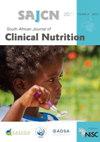The use of social media as a source of nutrition information
IF 0.6
Q4 NUTRITION & DIETETICS
引用次数: 1
Abstract
Introduction: There is an increase in young people’s engagement with social media (SM), specifically nutrition information. Nutrition misinformation is, however, prevalent on SM due to lack of professional gatekeeping of this user-generated content. Objectives: The study aimed to assess the use of SM as a platform for obtaining nutrition information and how the accuracy thereof is evaluated. Design: A descriptive cross-sectional study with an analytical component was conducted. Data were collected from 2 318 participants using a content- and face-validated self-administered online questionnaire. Descriptive statistics and relevant inferential statistics were used. A p < 0.05 indicates statistical significance. Setting: The survey was completed by students from Stellenbosch University, South Africa. Subjects: Undergraduate students (18–25 years) registered at Stellenbosch University (2021), South Africa (n = 2 318). Results: Of 2 318 participants (69% female), 1 615 used SM to access nutrition information, with YouTube being the most used platform for this purpose (96%). Females used SM significantly more than males (p < 0.001) and participants living in shared accommodation used SM significantly less than those in other living arrangements (p < 0.001). A minority (17%) of participants ‘actively’ turn to SM for nutrition information, while the majority (54%) engaged only if it happened to appear on their feed. The preferred nutrition content was ‘what to eat in a day’ (83%). Participants felt most comfortable following a registered dietitian (64%) for accurate nutrition information. Relatability (87%) was a characteristic that motivated participants to follow SM influencers and 16% trusted claims from health influencers on SM. Although 91% understood what evidence-based nutrition information means, 77% of participants struggled to determine the accuracy of nutrition information on SM, with females indicating significantly more difficulty than males (chi2 = 39, p < 0.001). Conclusion: The participants engaged with nutrition information on SM and understood what evidenced-based nutrition information is. However, the majority lack skill in determining information accuracy on SM. A dietitian was trusted most as a source of nutrition information.利用社交媒体作为营养信息的来源
本文章由计算机程序翻译,如有差异,请以英文原文为准。
求助全文
约1分钟内获得全文
求助全文
来源期刊

South African Journal of Clinical Nutrition
NUTRITION & DIETETICS-
CiteScore
2.50
自引率
9.10%
发文量
21
期刊介绍:
1.The Journal accepts articles from all basic and applied areas of dietetics and human nutrition, including clinical nutrition, community nutrition, food science, food policy, food service management, nutrition policy and public health nutrition. 2.The Journal has a broad interpretation of the field of nutrition and recognizes that there are many factors that determine nutritional status and that need to be the subject of scientific investigation and reported in the Journal. 3.The Journal seeks to serve a broad readership and to provide information that will be useful to the scientific community, the academic community, government and non-government stakeholders in the nutrition field, policy makers and industry.
 求助内容:
求助内容: 应助结果提醒方式:
应助结果提醒方式:


